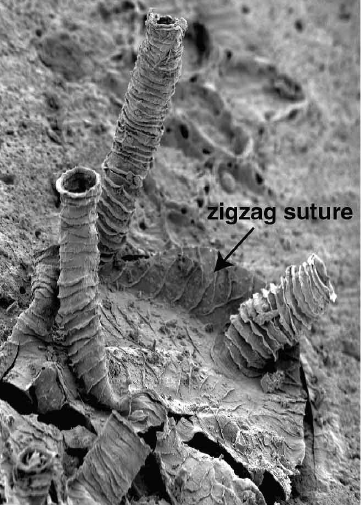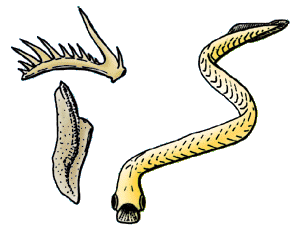|
Lilliput Effect
The Lilliput effect is a decrease in body size in animal species which have survived a major extinction. There are several hypotheses as to why these patterns appear in the fossil record, some of which are: the survival of small taxa, dwarfing of larger lineages, and the evolutionary miniaturization from larger ancestral stocks. The term was coined in 1993 by Adam Urbanek in his paper concerning the extinction of graptoloids and is derived from the island of Lilliput and Blefuscu, Lilliput inhabited by a miniature race of people in ''Gulliver's Travels, Gulliver’s Travels''. This size decrease may just be a temporary phenomenon restricted to the survival period of the extinction event. In 2019 Atkinson et al. coined the term the Brobdingnag effect to describe a related phenomenon operating in the opposite direction, whereby new species evolving after the Triassic–Jurassic extinction event, Triassic-Jurassic mass extinction originated at small body sizes before undergoing a size in ... [...More Info...] [...Related Items...] OR: [Wikipedia] [Google] [Baidu] |
Extinction
Extinction is the termination of a kind of organism or of a group of kinds (taxon), usually a species. The moment of extinction is generally considered to be the death of the last individual of the species, although the capacity to breed and recover may have been lost before this point. Because a species' potential range may be very large, determining this moment is difficult, and is usually done retrospectively. This difficulty leads to phenomena such as Lazarus taxa, where a species presumed extinct abruptly "reappears" (typically in the fossil record) after a period of apparent absence. More than 99% of all species that ever lived on Earth, amounting to over five billion species, are estimated to have died out. It is estimated that there are currently around 8.7 million species of eukaryote globally, and possibly many times more if microorganisms, like bacteria, are included. Notable extinct animal species include non-avian dinosaurs, saber-toothed cats, dodos, m ... [...More Info...] [...Related Items...] OR: [Wikipedia] [Google] [Baidu] |
Fossil Record
A fossil (from Classical Latin , ) is any preserved remains, impression, or trace of any once-living thing from a past geological age. Examples include bones, shells, exoskeletons, stone imprints of animals or microbes, objects preserved in amber, hair, petrified wood and DNA remnants. The totality of fossils is known as the ''fossil record''. Paleontology is the study of fossils: their age, method of formation, and evolutionary significance. Specimens are usually considered to be fossils if they are over 10,000 years old. The oldest fossils are around 3.48 billion years old to 4.1 billion years old. Early edition, published online before print. The observation in the 19th century that certain fossils were associated with certain rock strata led to the recognition of a geological timescale and the relative ages of different fossils. The development of radiometric dating techniques in the early 20th century allowed scientists to quantitatively measure the absolu ... [...More Info...] [...Related Items...] OR: [Wikipedia] [Google] [Baidu] |
Taxa
In biology, a taxon (back-formation from ''taxonomy''; plural taxa) is a group of one or more populations of an organism or organisms seen by taxonomists to form a unit. Although neither is required, a taxon is usually known by a particular name and given a particular ranking, especially if and when it is accepted or becomes established. It is very common, however, for taxonomists to remain at odds over what belongs to a taxon and the criteria used for inclusion. If a taxon is given a formal scientific name, its use is then governed by one of the nomenclature codes specifying which scientific name is correct for a particular grouping. Initial attempts at classifying and ordering organisms (plants and animals) were set forth in Carl Linnaeus's system in ''Systema Naturae'', 10th edition (1758), as well as an unpublished work by Bernard and Antoine Laurent de Jussieu. The idea of a unit-based system of biological classification was first made widely available in 1805 in the int ... [...More Info...] [...Related Items...] OR: [Wikipedia] [Google] [Baidu] |
Graptoloids
Graptolites are a group of colonial animals, members of the subclass Graptolithina within the class Pterobranchia. These filter-feeding organisms are known chiefly from fossils found from the Middle Cambrian (Miaolingian, Wuliuan) through the Lower Carboniferous ( Mississippian). A possible early graptolite, ''Chaunograptus'', is known from the Middle Cambrian. Recent analyses have favored the idea that the living pterobranch ''Rhabdopleura'' represents an extant graptolite which diverged from the rest of the group in the Cambrian. Fossil graptolites and ''Rhabdopleura'' share a colony structure of interconnected zooids housed in organic tubes (theca) which have a basic structure of stacked half-rings (fuselli). Most extinct graptolites belong to two major orders: the bush-like sessile Dendroidea and the planktonic, free-floating Graptoloidea. These orders most likely evolved from encrusting pterobranchs similar to ''Rhabdopleura''. Due to their widespread abundance, plantkonic l ... [...More Info...] [...Related Items...] OR: [Wikipedia] [Google] [Baidu] |
Lilliput And Blefuscu
Lilliput and Blefuscu are two fictional island nations that appear in the first part of the 1726 novel ''Gulliver's Travels'' by Jonathan Swift. The two islands are neighbours in the South Indian Ocean, separated by a channel wide. Both are inhabited by tiny people who are about one-twelfth the height of ordinary human beings. Both are empires, i.e. realms ruled by an emperor. The capital of Lilliput is Mildendo. In some pictures, the islands are arranged like an egg, as a reference to their egg-dominated histories and cultures. Location Swift gives the location of Lilliput and Blefuscu in Part I of ''Gulliver's Travels'', both in the text and with a map, though neither correspond to real-world geography, even as it was known in Swift's time. The text states that Gulliver's ship (the ''Antelope'') was bound for the East Indies when it was caught in "a violent storm to the northwest of Van Diemen's Land" (Tasmania). He gives the latitude as 30°2'S, though the longitude is u ... [...More Info...] [...Related Items...] OR: [Wikipedia] [Google] [Baidu] |
Gulliver's Travels
''Gulliver's Travels'', or ''Travels into Several Remote Nations of the World. In Four Parts. By Lemuel Gulliver, First a Surgeon, and then a Captain of Several Ships'' is a 1726 prose satire by the Anglo-Irish writer and clergyman Jonathan Swift, satirising both human nature and the "travellers' tales" literary subgenre. It is Swift's best known full-length work, and a classic of English literature. Swift claimed that he wrote ''Gulliver's Travels'' "to vex the world rather than divert it". The book was an immediate success. The English dramatist John Gay remarked: "It is universally read, from the cabinet council to the nursery." In 2015, Robert McCrum released his selection list of 100 best novels of all time in which ''Gulliver's Travels'' is listed in third place as "a satirical masterpiece". Plot Part I: A Voyage to Lilliput The travel begins with a short preamble in which Lemuel Gulliver gives a brief outline of his life and history before his voyages. ;4 May ... [...More Info...] [...Related Items...] OR: [Wikipedia] [Google] [Baidu] |
Brobdingnag Effect
Brobdingnag is a fictional land, which is occupied by giants, in Jonathan Swift's 1726 satirical novel ''Gulliver's Travels.'' The story's main character, Lemuel Gulliver, visits the land after the ship on which he is travelling is blown off course. As a result, he becomes separated from a party exploring the unknown land. In the second preface to the book, Gulliver laments that the publisher misspelled the land's name, which Gulliver asserts is actually called Brobdingrag. The adjective "Brobdingnagian" has come to describe anything of colossal size. Location Swift describes the location of Brobdingnag and its geography in Part II of ''Gullivers Travels'' and provides a map showing where it is. However, the accounts are somewhat contradictory. The map printed at the beginning of Part II indicates that Brobdingnag is located on the northwest coast of North America, in probably what is now British Columbia. The map shows (from south to north) Point Monterey, Port Sir Francis D ... [...More Info...] [...Related Items...] OR: [Wikipedia] [Google] [Baidu] |
Triassic–Jurassic Extinction Event
The Triassic–Jurassic (Tr-J) extinction event, often called the end-Triassic extinction, marks the boundary between the Triassic and Jurassic periods, , and is one of the top five major extinction events of the Phanerozoic eon, profoundly affecting life on land and in the oceans. In the seas, the entire Class (biology), class of conodonts and 23–34% of marine genus, genera disappeared. On land, all Archosauromorpha, archosauromorphs other than Crocodylomorpha, crocodylomorphs, pterosaurs, and dinosaurs became extinct; some of the groups which died out were previously abundant, such as aetosaurs, phytosaurs, and Rauisuchidae, rauisuchids. Some remaining non-mammalian therapsids and many of the large Temnospondyli, temnospondyl amphibians had become extinct prior to the Jurassic as well. However, there is still much uncertainty regarding a connection between the Tr-J boundary and terrestrial vertebrates, due to a lack of terrestrial fossils from the Rhaetian (latest) stage of the ... [...More Info...] [...Related Items...] OR: [Wikipedia] [Google] [Baidu] |
Brobdingnag
Brobdingnag is a fictional land, which is occupied by giants, in Jonathan Swift's 1726 satirical novel ''Gulliver's Travels.'' The story's main character, Lemuel Gulliver, visits the land after the ship on which he is travelling is blown off course. As a result, he becomes separated from a party exploring the unknown land. In the second preface to the book, Gulliver laments that the publisher misspelled the land's name, which Gulliver asserts is actually called Brobdingrag. The adjective "Brobdingnagian" has come to describe anything of colossal size. Location Swift describes the location of Brobdingnag and its geography in Part II of ''Gullivers Travels'' and provides a map showing where it is. However, the accounts are somewhat contradictory. The map printed at the beginning of Part II indicates that Brobdingnag is located on the northwest coast of North America, in probably what is now British Columbia. The map shows (from south to north) Point Monterey, Port Sir Francis D ... [...More Info...] [...Related Items...] OR: [Wikipedia] [Google] [Baidu] |
Graph Demonstrating A Decreasee In Body Size Post Extinction Event, Adapted From Twitchett 2007
Graph may refer to: Mathematics *Graph (discrete mathematics), a structure made of vertices and edges **Graph theory, the study of such graphs and their properties *Graph (topology), a topological space resembling a graph in the sense of discrete mathematics *Graph of a function *Graph of a relation *Graph paper *Chart, a means of representing data (also called a graph) Computing *Graph (abstract data type), an abstract data type representing relations or connections *graph (Unix), Unix command-line utility *Conceptual graph, a model for knowledge representation and reasoning Other uses * HMS ''Graph'', a submarine of the UK Royal Navy See also *Complex network *Graf *Graff (other) *Graph database *Grapheme, in linguistics *Graphemics *Graphic (other) *-graphy (suffix from the Greek for "describe," "write" or "draw") *List of information graphics software *Statistical graphics Statistical graphics, also known as statistical graphical techniques, are graphic ... [...More Info...] [...Related Items...] OR: [Wikipedia] [Google] [Baidu] |
Animal Size
Animals are multicellular, eukaryotic organisms in the biological kingdom Animalia. With few exceptions, animals consume organic material, breathe oxygen, are able to move, can reproduce sexually, and go through an ontogenetic stage in which their body consists of a hollow sphere of cells, the blastula, during embryonic development. Over 1.5 million living animal species have been described—of which around 1 million are insects—but it has been estimated there are over 7 million animal species in total. Animals range in length from to . They have complex interactions with each other and their environments, forming intricate food webs. The scientific study of animals is known as zoology. Most living animal species are in Bilateria, a clade whose members have a bilaterally symmetric body plan. The Bilateria include the protostomes, containing animals such as nematodes, arthropods, flatworms, annelids and molluscs, and the deuterostomes, containing the echinoderms an ... [...More Info...] [...Related Items...] OR: [Wikipedia] [Google] [Baidu] |

.jpg)



_-_New_Holland_-_Dimens_Land.png)


